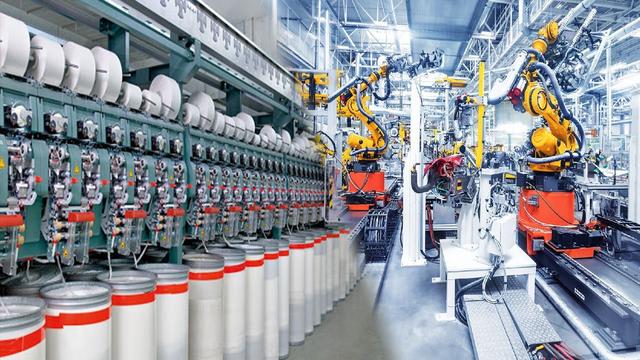Introduction
FactoryAutomation(abbreviation:FA),factoryautomation,alsoknownasworkshopautomation.Referstothenatureofautomaticallycompletingallorpartoftheprocessingprocessofproductmanufacturing:referstotherealizationofcomprehensiveautomationoftheentirefactory,whichincludestheautomationofdesign,manufacturingandprocessing,andtheoverallautomationofinformationflowsuchasinternalmanagement,marketinformationprocessing,andinformationcontactbetweenenterprises.Itandinformationandcommunication,officeautomation,newmaterials,bioengineering,healthcareandmedicaltechnologyarelistedasthesixleadingnewtechnologiesofthecontemporaryera.Itsconventionalcompositionmethodistoconnectvariousprocessingautomationequipmentandflexibleproductionlines(FML),cooperatewithcomputer-aideddesign(CAD)andcomputer-aidedmanufacturing(CAM)systems,andcoordinateworkundertheunifiedmanagementofacentralcomputertomaketheentirefactoryproduceRealizecomprehensiveautomation.Technology(seeAutomation,MachineryManufacturingandAutomation).
FactoryAutomation(2photos)

DevelopmentHistory
Sincethe1930s,peoplebegantousedecentralizedmeasuringinstrumentsandThecontroldeviceperformsautomaticadjustmentofasingleparameter,replacingthetraditionalmanualoperation.
Inthe1950s,peoplebegantocentralizedetectionandcontrolinstrumentsinthecentralcontrolroomtoimplementcentralizedcontroloftheworkshop.Somefactoriesandenterprisesinitiallyrealizedinstrumentationandpartialautomationofdetection.Atthisstage,mostoftheprocesscontrolsystemstructureisstillasingle-inputsingle-outputsystem.Thecontrolledvariablesaremainlyfourparameters:temperature,pressure,flowandliquidlevel.Thepurposeofcontrolistomaintainthestabilityoftheseparametersandeliminateorreducetheimpactonproduction.Interferenceinfluenceoftheprocess.Themethodadoptedbytheprocesscontrolsystemisthefrequencymethodandthetrajectorymethodintheclassicalcontroltheory,whichmainlysolvestheconstantvaluecontrolofthesingle-inputsingle-outputsystemandthecomprehensivecontrolofthesystem.
Inthe1960s,withthecontinuousdevelopmentofindustrialproduction,thedegreeoffactoryautomationwasgreatlyimproved.Intermsofautomationinstruments,alargenumberofunitcombinationinstrumentshavebeguntobeadopted.Inordertomeettherequirementsofstereotyped,flexible,andmulti-functional,assembledinstrumentshavealsoappearedtomeettheneedsofcontrolsystemsthatcombinemorecomplexsimulationandlogiclaws.Atthesametime,electroniccomputersbegantobeusedtooptimallycontrollarge-scaleequipment,suchaslargedistillationtowers,largerollingmills,etc.,toachievedirectdigitalcontrol(DDC)andsetpointcontrol(SPC).Intermsofsystems,acompoundcontrolsystemincludingfeedbackandfeedforwardhasappeared.Intermsofprocesscontroltheory,inadditiontostilladoptingclassicalcontroltheorytosolvetheproblemsintheactualproductionprocess,moderncontroltheoryhasalsobeguntobeapplied,andthecontrolsystemhaschangedfromasingle-variablesystemtoacomplexmulti-variablesystem.Duringthisperiod,factoriesandenterpriseshaverealizedcentralizedcontrolofworkshopsorlarge-scaleinstallations.
Fromthe1970stothe1990s,therapiddevelopmentofmodernindustrialproduction,thedevelopmentofautomatedinstrumentsandhardware,andtheadventofmicrocomputersenabledtheautomationoftheproductionprocesstoenteranewhigh-levelstage.Centralizedcontroloftheentirefactoryortheentireprocess,theapplicationofacomputersystemformulti-parametercomprehensivecontrol,ortheuseofmultiplecomputersforhierarchicalcomprehensivecontroloftheproductionprocessandparticipationinbusinessmanagementarethemainfeaturesofthisstage.Intermsofnewautomationtechnologytools,webegantousemicrocomputer-controlledintelligentunitcombinationmeters,displayandadjustmentmeterstomeettheneedsofvariouscomplexcontrolsystems.Thedesignmethodsandspecialcontrollawssuchasstatefeedback,optimalcontrolandadaptivecontrolinmoderncontroltheoryhavebeenwidelyusedinprocesscontrol,andautomationtechnologypresentsanewandprosperousscene.
Sincethebeginningofthe21stcentury,theconceptsof"people-oriented"and"energysavingandenvironmentalprotection"havebeendeeplyrootedintheheartsofthepeople,andnewrequirementshavebeenputforwardforfactoryautomation.Withthecontinuousdevelopmentandinnovationofscienceandtechnologysuchascomputertechnology,wirelesstechnology,fieldbustechnology,industrialEthernettechnology,ITtechnology,robotics,sensortechnology,andsafetytechnology,factoryautomationhasexperiencedstand-aloneautomation,workshopautomation,andplant-wideautomation.Afterseveralimportantstagessuchascentralizedcontrol,itisdevelopingtowardsintegratedfactoryautomation(alsoknownastotalautomation),thatis,integratingprocesscontrol,supervisorycontrol,productdesign,qualitymonitoring,factorymanagement,etc.,usingmoderncontroltheoryandlarge-scalesystemsTheory,artificialintelligence,4C(Computer,Commu-Iieation,CRT,Control)technologytoachieveoptimizedcontrol,hierarchicalcontrol,decentralizedcontrol,testautomation,buildingautomation,informationprocessingandbusinessdecision-makingautomation,inordertofurtherimproveworkefficiencyandensureQualityandsafety,savingenergyandrawmaterials.
Factoryautomationachievements
AccordingtotheAmericanAcademyofSciencesinvestigationandanalysisoffivecompaniesincludingMcDonnellDouglasAircraftCompany,DeereTractorCompany,GeneralMotorsCompany,WestinghouseCompanyandIngersollMillingMachineCompany.Thefollowingbenefitsareobtainedbyadoptingtheintegratedcontrolofthewholeplant:productqualityisincreasedby2to5times,productionefficiencyisincreasedby40to70%,equipmentutilizationrateisincreasedby2to3times,productioncycleisshortenedby30to60%,andengineers'workabilityisimproved.3-35times.
